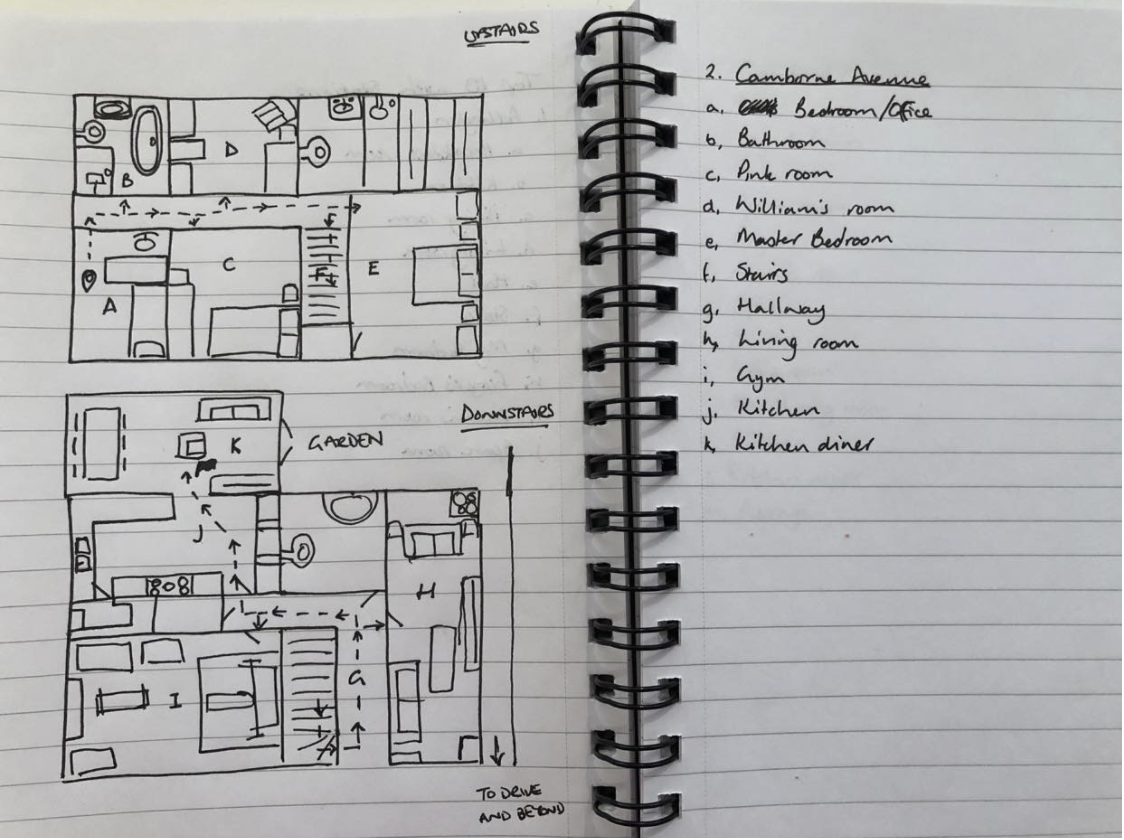
- At the core of cognitive behavioral therapy (CBT) is the inquisitive statement: “Are my thoughts useful?”
- This statement relates back to the idea that many people suffer from experiencing negative thoughts—not from the thoughts themselves.
- Ancient core traditions such as Advaita Vedanta, Yoga, and Stoicism all allude to the importance of mastering one’s thought patterns.
- Using modern techniques, activities such as the creation of a “Memory Palace” can be of great assistance to anyone looking to stop unwanted thoughts.
- The most important part of CBT -based techniques (or any self-improvement exercise) is to practice at least 4 times per week in order to make thought replacement a firm habit.
For years, I experienced unwanted thoughts. I’ll spare you the gruesome details, but chances are, you or someone you love knows just how bad the mind can get. In fact, we know a lot more than ever before the kinds of pain people are going through. To take some examples:
- The online counseling industry continues steadily growing as the internet involves.
- Many psychologists have developed large followings on platforms like YouTube.
- Ancient mental strength strategies like Stoicism are enjoying a resurgence in popularity.
The best part? You can rapidly learn two scientifically valid means of stopping unwanted thoughts. Although you should always run any technique past a doctor or qualified counselor, these techniques are easy to learn and fun. The fact of the matter is, I only started using them myself because the data is too solid not to give them a try. So if you’re skeptical, that’s actually a good thing, and in this article, I’ll be sharing the evidence that substantiates how and why these techniques work.

CBT: A Brief History of Using Thoughts to Improve Your Mind
There’s an ancient proverb that says, “The mind is a wonderful servant but a terrible master.” In other words, we often let our minds push us around and “master” our experiences. In reality, thoughts are just mental content that appears in consciousness. We can get them to “serve” us in highly effective and efficient ways. Arguably, the mental techniques that are now called cognitive behavioral therapy have evolved over thousands of years from philosophical schools typically associated with spirituality:
- Advaita Vedanta
- Zen
- Hermetic traditions
- Yoga
But it wasn’t really until 1955 when Albert Ellis codified REBT that a secular and scientific means of using thoughts to improve mental experiences arose. There are several differences between REBT and CBT, but Ellis’ influence is clear. In a nutshell, his work helped people focus first and foremost on “their disturbance about being disturbed” (Albert Ellis Reader xvi). As Ellis has remarked, it was his knowledge of these earlier traditions, rather than what other psychotherapists were doing, that helped him see that many people suffer more from having certain thoughts than the thoughts themselves. Since Ellis, CBT has become a valid school, and everyone from professors like Brene Brown to TV anchors like Dan Harris have shared scientifically validated thought processes that produce reliable, therapeutic outcomes.
What Kinds of Thoughts Work?
The catch to anything that is scientifically validated is the individual still needs to want to use the techniques. For years, I knew about some of them from many hours spent with therapists who were very good. But as I talk about in The Victorious Mind, I was such a chronic “control freak,’ that I didn’t give them or their research the benefit of the doubt. As a result, I wound up suffering much longer than necessary. However, I was lucky that eventually science did win because I finally discovered a book that was speaking my kind of language.
A friend suggested I read Dr. Gary Weber’s Evolving Beyond Thought because Weber had memorized some ancient Sanskrit to deal with his own unruly thoughts. Since I know how to memorize just about anything quickly, and since Weber talked about these ancient texts in scientific terms, I gave the techniques a try. Ultimately, the kind of thoughts I learned to apply are self-reflective in nature. They draw attention to the nature of the thoughts themselves.
Two, in particular, have been particularly useful: Are my thoughts useful? How do they behave? Although I love learning languages and personally enjoy reciting Sanskrit, I do not see any reason why Sanskrit is necessary. However, it is likely the case that the brain benefits associated with language learning contribute to improved executive control. Language learning may also help with filtering out unnecessary words, and working in another language surely adds a layer of positive distraction.
Are My Thoughts Useful? The Benefits of Self-Reflexive Thinking
I believe simple questions like this help because they draw your attention to what is essentially a strange loop.
For example, I used to have endless arguments with people in my mind. If things hadn’t gone the way I liked, hours of internal discussion would be wasted on playing alternative versions of what I remembered.
But when I learned these simple questions, I was able to kick my foot into a gap between the words churning away in my mind.
Question: “Are these thoughts useful?”
Answer: “No. I’m talking to myself about the past and a situation that cannot be changed.”
Question: “How do these thoughts behave?”
Answer: “Like a little frustrated child who needs a nap.”
When we start to recognize the thoughts reflexively, we receive clues to how we can change the behavior involved in the thinking. Dr. Weber has many more useful questions like these in Evolving Beyond Thought, but these two on their own really deliver. I have benefitted from them so much, I based a complete TEDx Talk on them. Some people have pointed out that these questions resemble the main four questions taught by Byron Katie:
- Is it true?
- Can you absolutely know that it’s true?
- How do you react, what happens, when you believe that thought?
- Who would you be without the thought?
Ultimately, each person needs to figure out what thoughts they will adopt to combat their unwanted thoughts. It doesn’t necessarily have to be questions. Working with a qualified therapist can help you arrive at what will work best for you and how to evolve the new mental content you use over time.
How to Remember New, Desirable Thoughts
Since many people suffering from unwanted thoughts are bound to forget new mental content that can help them, here’s a suggestion: Turn your home into a Memory Palace. What is a Memory Palace? It’s a mental recreation of your home or another familiar building. In fact, you can have several, including your office, school, and shopping center. I suggest people draw simple plans to get started. Like this:

As you can see, you don’t have to be a great artist. You just chart out a path and list the “Stations” where you will leave information along a “journey.”
Let’s say that you want to memorize: “Are my thoughts useful?”
To this, pick a spot in your home, like the kitchen. You can probably boil the question down to just one word: useful.
To remember it, create an association. Typically, we do this based on sound. For example, you could imagine Neil Armstrong planting the US flag on your kitchen counter. (The sound of US is like “useful.”)
You can even imagine Armstrong asking the flag if his thoughts are useful to really compound it home. Because doing such a thing is quite silly, you’re much more likely to remember both the image and the associated question.
How to Add a Positive Twist
The Memory Palace technique has been around for thousands of years. Although it is mostly known by medical students and memory competitors, researchers are still finding new uses for it. Dr. Tim Dalgleish is one such explorer. As his research has shown, using this technique has helped people cope better with everything from PTSD to depression. In his work, he calls the technique the method of loci, which points to the same strategy of using locations tied together with imagery to help us remember words, ideas or processes.
But Dr. Dalgleish takes things one step further, a strategy that has helped ease my chronic pain and clinical depression suffering. And the benefits arise just as his research findings strongly suggest will happen for most people who practice the technique. In his research, he found that placing positive memories along the Memory Palace journey and recalling them during times of distress improved substantially. Even before discovering his work, I noticed mood benefits from using these processes when I was in grad school.
To use this technique, imagine assigning happy memories around different parts of your home. If times get tough, mentally enter your Memory Palace. Start with the first memory and go through as many as necessary. Soon, you’ll probably start to feel mental relief. Here’s an example to make the process concrete. In my Dalgleish inspired Memory Palace, I have:
- The memory of performing magic tricks for my graduate committee after I successfully defended my PhD
- The memory of meeting my wife
- The memory of playing a particularly successful concert with my band
- The memory of seeing some of my books succeed in the Amazon rankings
I use this technique more for when my mood tips, and save the questions for when I am experiencing unwanted thoughts. But of course, there is no standard approach and the more tools we have, the more readily we can find our personal, therapeutic style.
How to Remember to Use the Techniques
Again, I think everything starts with wanting to see a change in your life and embracing a strategy. After that, memory science makes it pretty clear that you need to develop habits that strengthen your procedural memory. Nothing happens on autopilot, but as research shared by many recent books like Atomic Habits, The Talent Code and 59 Seconds, once you have enough dopamine and myelin sheaths wrapped around your neurons, you practically crave the process.
It’s kind of like how people start craving their workouts at the gym, even though they are challenging. At the end of the day, these techniques deeply resemble meditation. And there, much research shows that one needs to practice at least four times a week to receive the benefits. Some research even shows that with this minimal amount of practice, the results can start pouring in quite quickly.
If you’re anything like me, you might start out practicing four times an hour. In my experience with these techniques, that amount of practice was perfectly okay. In fact, it was more than okay back and still provides blessed relief on a daily basis. And I appreciate very much that I can do it all based on science, while remaining fascinated by just how long all of these techniques have been with us.
Anthony Metivier is the founder of the Magnetic Memory Method, a systematic, 21st Century approach to memorizing foreign language vocabulary, dreams, names, music, poetry, and much more in ways that are easy, elegant, effective, and fun.













